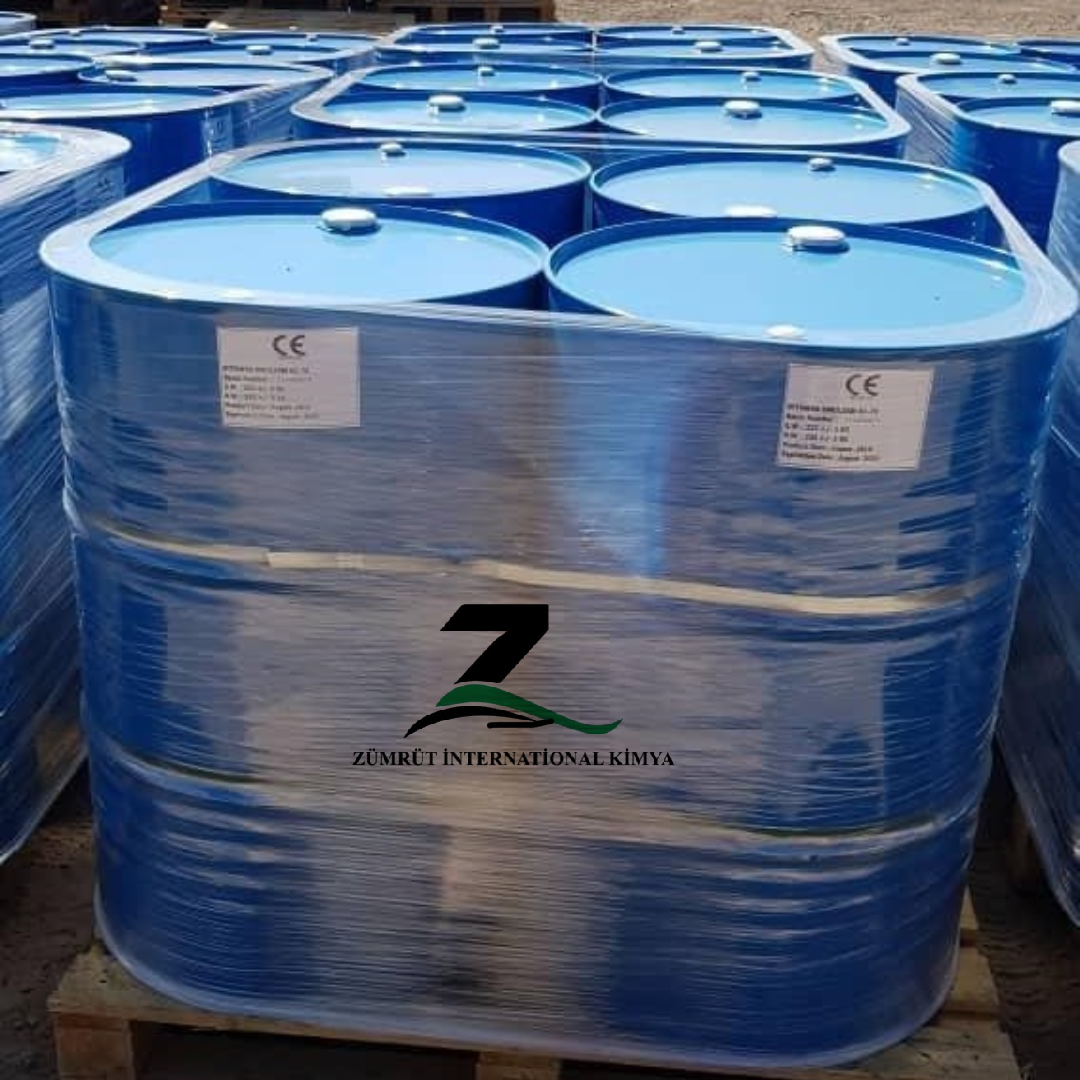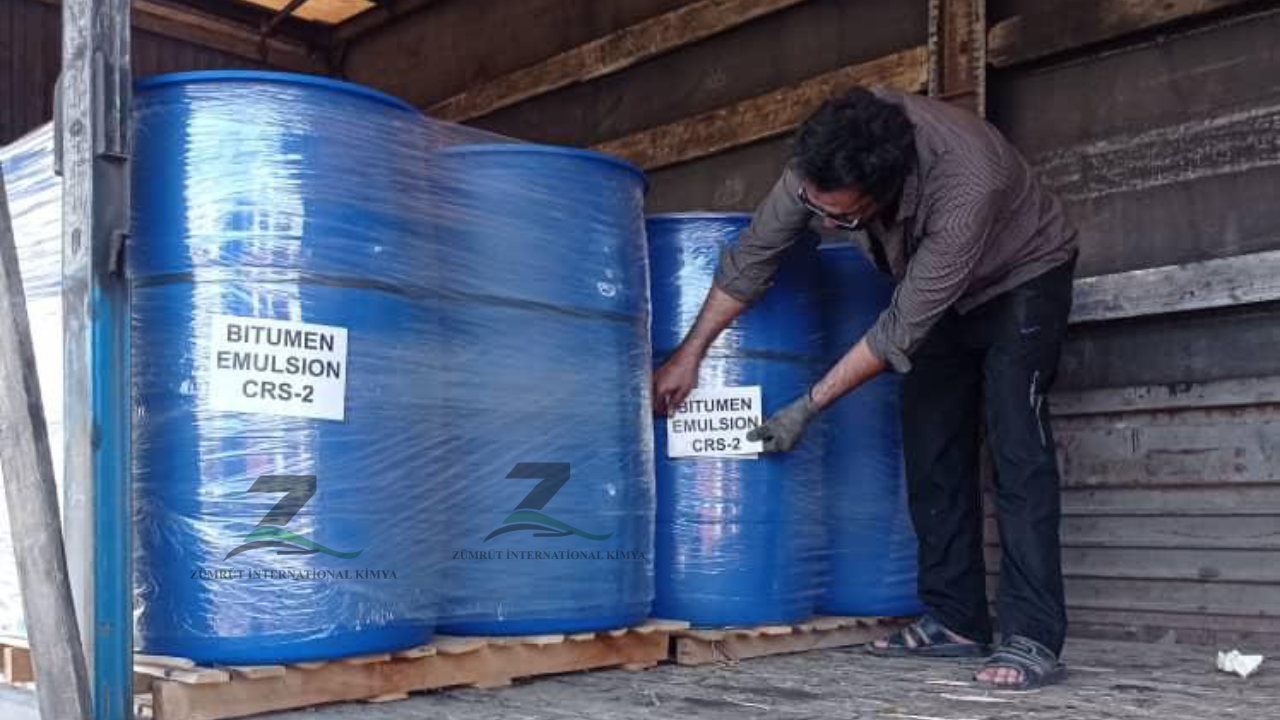
Cationic Bitumen Emulsion CRS-2 Description
Cationic Bitumen Emulsion CRS-2 is another type of bitumen emulsion used in road construction. Similar to CRS-1, it consists of bitumen droplets dispersed in water, but with different characteristics. CRS-2 is typically formulated with a slightly higher viscosity and a different emulsifying agent compared to CRS-1, making it suitable for specific applications where greater stability and adhesion are required. It’s commonly used for chip seals, tack coats, prime coats, and other pavement maintenance treatments, offering excellent adhesion and durability.
Bitumen emulsion consists of three basic ingredients: bitumen, water, and an emulsifying agent. Based on specifications it may contain other additives, such as stabilizers, coating improvers, anti-strips, or break control agents. It is well known that water and asphalt will not mix, except under carefully controlled conditions using highly specialized equipment and chemical additives.
Cationic Bitumen Emulsion CRS-2 is a cationic emulsion. Bitumen emulsion CRS-2 are usually made by passing the mixture of hot bitumen and water phase between a rotating disc, cone or wheel and a stator. In the emulsification process, the hot binder is mechanically separated into minute globules and dispersed in water treated with a small quantity of emulsifying agent. The water is called the continuous phase and the globules of the binder are called the discontinuous phase by proper selection of an emulsifying agent and other manufacturing controls.
Cationic bitumen emulsions CRS-2 have a positive charge and hence a direct and very rapid reaction between the emulsion and an aggregate or pavement is possible. The size of the charge or the Zeta potential affects stability, the larger the charge the greater the repulsion, but as the aggregate is negatively charged the higher the zeta potential the more rapid the reaction.
So it is possible to stabilize a cationic emulsion in the same way that makes it a more rapid break. The other mechanism of evaporation is available too but as the emulsion is stabilized this form of break becomes slower. Thus a balance must be struck. After the electrostatic part of the reaction is complete the emulsion will rely on flocculation and coalescence to complete break.
After the break is completed the water must still be completely evaporated for the residual Asphalt to achieve full strength.
Bitumen Emulsion CRS-2 Applications
Bitumen Emulsion CRS-2 finds applications in various road construction tasks, including:
- Chip Seals: Used as a binder for aggregate chips to create durable wearing surfaces on roads, providing protection against weathering and traffic abrasion.
- Tack Coats: Applied to ensure proper bonding between pavement layers or between pavement and overlays, enhancing the overall structural integrity of the road.
- Prime Coats: Applied to prepare the base course before laying the asphalt layer, promoting adhesion between the base and surface layers and improving waterproofing.
- Surface Treatments: Utilized for various surface treatments such as slurry seals and microsurfacing to rejuvenate and protect existing pavements, enhancing skid resistance and prolonging pavement life.
- Pothole Repair: CRS-2 can be used for patching and repairing localized areas of distressed pavement, providing a cost-effective solution for maintaining road infrastructure.
Its versatility and adhesive properties make it suitable for a wide range of road construction and maintenance applications, contributing to the longevity and performance of pavement structures.
Successful performance of bitumen emulsions requires selecting the proper type and grade for the intended use. Guidelines presented in this chapter should help select the specific grade and type of emulsion to be used.
The first consideration in picking the right type and grade of the emulsion is how the emulsion will be used. Is it for a planned mix (central or mixed-in-place), a recycled mix, or a prime coat application? Is it for some type of surface application, such as a fog seal, slurry seal, micro surfacing, or chip seal? Is it for a maintenance mix? Once this decision is made, other project variables must then be considered. Some other factors that affect the selection are:
• Climatic conditions anticipated during construction. The choice of emulsion grade, the design of mix or treatment, and the selection of construction equipment should be dictated by the conditions at the time of construction.
• Aggregate type, gradation, and availability.
• Contractor or construction equipment availability.
• Geographical location. The hauling distance and, in some cases, water availability are important considerations.
the hauling distance and, in some cases, water availability are important considerations.
• Traffic control. Can traffic be detoured or only controlled through the work area?
• Environmental considerations.
• Proper application for pavement preservation or pavement distresses.
• Traffic type and volume.
While general guidelines can be given for selecting emulsions, laboratory testing is strongly recommended. There is no substitute for a laboratory evaluation of the emulsion and the aggregate to be used. Different types and quantities of emulsion should be tried with the aggregate to find the best combination for the intended use. An experienced technician can determine the type and grade of the emulsion to be used.
Cationic emulsions are preferred for use with negatively charged siliceous aggregates such as quartz, granite, sandstone and river gravel. In general, Cationic emulsions can be used with a wider range of aggregates, will tolerate greater quantities of moisture, and will break at a lower ambient temperature. The main application areas of Emulsion bitumen are surface dressing, tack coats, prime coat, slurry seal, and cold mixing.
Dust control (SS-1, CS-1, CRS-1)
Tack coat (SS-1, SS-1h, CSS-1, CSS-1h, CRS-1)
Prime coat (SS-1, SS-1h, CSS-1, CSS-1h)
Fog seal (SS-1, CSS-1, MS-1-CMS-2, CRS-1)
Penetration prime (SS-1)
Cold mix asphalt, Mulching, Asphalt Sealers (CSS-1)
Chip seal, single, or multiple treatments (RS-1, RS-2, HFMS-1, HFMS-2, HFRS-2, CRS-2, and CRS-2P)
Sand seal (SS-1, SS-1h, CSS-1, CSS-1h, CMS-2s, CRS-1, CRS-2)
Slurry seal (SS-1h, CSS-1h, CSS-1Hp)
Sandwich seal, cape seal, chip seal (CR-2)
Micro surfacing (CQS-1h)
Structural and surface plant mixture (SS-1, SS-1h, HFMS-2s, CSS-1, CSS-1h,)
Stockpiled patching mixture (HFMS-2s, CMS-2s)
In-place road mixing (SS-1, SS-1h, HFMS-2s, HFMS-2, HFMS-2h CMS-2, CMS-2h, CSS-1, CSS-1h)
Crack filler, joint coating (RS-2, HFMS-2h, MS-2, CMS-2h, CRS-2P)
Asphalt sealers, Immediate Maintenance, Stockpile Maintenance Mixes (CMS-2)
Immediate Maintenance (CM2, CM2h)

CRS-2 Advantages
• No petroleum solvent required to liquefy
• Little or no hydrocarbon emissions
•Because of low viscosity of the Emulsion as compared to hot applied Bitumen, The Emulsion has a good penetration and spreading capacity.
• In most cases, used with no additional heat. It does not need any pre-heating. Thus results in the case of handling for the user, besides saving in cost.
• The ability to coat damp aggregate
• Can use cold materials at remote sites. Cold application of Bitumen Emulsion ensures safety to the workforce; it is a user-friendly product. Being cold applied the work progresses much faster.
• Wide variety of emulsion types available today
• Economical
• Free from danger ( for fire )
• Environmental
• Harmless for worker health.
• It can use with moisture aggregates. It can be used even with wet aggregates thus enabling users to carry out work during the monsoon also.
• Application temperature is low and does not need heating while storage and transportation period. For this reason, it provides energy saving.
• Emulgators increase adhesion they effect as anti-stripping agent
• It can use in four seasons. Especially it gives a chance application in the rainy region and it extends application period.
• It has a lot of application area and construction methods.
• Cationic Bitumen Emulsion CRS-2 does not require petroleum solvent to make them liquid as in cut back and also it is not required to be heated like normal Bitumen. Thus saving imported petroleum oil or firewood.
• Toxic fumes (Hydrocarbon emission) normally emitted from heated bitumen & cutbacks not present when Cationic Bitumen Emulsion is used, as no heating is required for its application.
• Energy saving & control of pollution & safety:
During the last 10-12 yrs., the country was in the quest for alternatives to Hot Mixing technology especially to save our beleaguered environment besides curbing the use of Imported petroleum oil, and our precious forests supplying firewood. Optimum use of Bitumen-emulsions can preserve Petroleum Oil and in turn, save our Environment and Foreign Exchange.s application.
Packing of Asphalt Emulsion CRS-2
ZUMRUT Co. Bitumen Emulsion CRS-2 is available in:
Bulk as IBC Tank, FlexiTank
Reconditioned steel drums 220 lit., Net Weight: 200 ± 3 Kg
New steel drums 220 lit., Net Weight: 200 ± 3 Kg
Storage and Handling CRS-2
- Storage Temperature: Store CRS-2 in a covered area to protect it from direct sunlight and extreme temperatures. The recommended storage temperature typically ranges from 10°C to 35°C (50°F to 95°F). Avoid storing CRS-2 at temperatures below freezing, as it can lead to emulsion breakdown.
- Ventilation: Ensure that the storage area is well-ventilated to prevent the accumulation of flammable vapors. Store CRS-2 away from sources of ignition, such as open flames, sparks, or hot surfaces.
- Agitation: Before use, gently agitate or stir the emulsion to ensure uniform consistency. Avoid excessive agitation, as it may cause foaming or destabilization of the emulsion.
- Handling: When handling CRS-2, wear appropriate personal protective equipment (PPE), including gloves and goggles, to prevent skin contact and eye irritation. Avoid inhalation of vapors by working in well-ventilated areas or using respiratory protection if necessary.
- Spills and Cleanup: In the event of spills, contain the material and clean it up promptly using absorbent materials. Dispose of contaminated materials properly according to local regulations.
Cationic bitumen emulsion CRS-2 Specifications
Emulsion Type: Rapid-Setting
Grade: CRS-2
Standard: ASTM D 2397M – 13
| PropertyProperty | Min | Max | Test Method |
| Test on Emulsions | |||
| Viscosity, Saybolt Furol at 25 °C, SFS | 100 | 400 | ASTM D244 |
| Storage stability test, 24-h, % | – | 1 | ASTM D6930 |
| Demulsibility, 35 mL, 0.8 % dioctyl sodium sulfosuccinate, % | 40 | – | ASTM D6936 |
| Coating ability and water resistance: | |||
| Particle charge test | Positive | ASTM D244 | |
| Sieve test, % | – | 0.1 | ASTM D6933 |
| Distillation : | |||
| Oil distillate, by volume of emulsion, % | – | 3 | ASTM D6997 |
| Residue, % | 65 | – | ASTM D244 |
| Tests on residue from distillation test: | |||
| Penetration, 25°C (77°F), 100 g, 5 s | 100 | 250 | ASTM D5 |
| Ductility, 25°C (77°F), 5 cm/min, cm | 40 | – | ASTM D113 |
| Solubility in trichloroethylene, % | 97.5 | – | ASTM D2042 |



